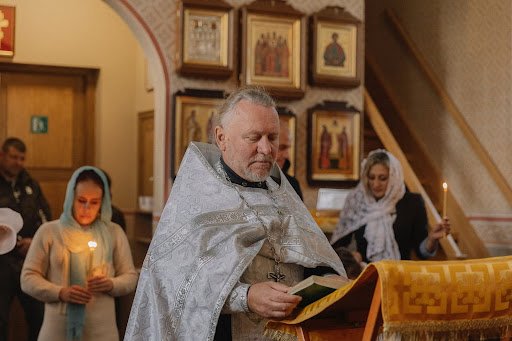Creating Holiday Inclusion in the Workplace through Observing an Orthodox Christmas and a Western Christmas (Copy)
Image Description: An Orthodox Christian presbyter, or priest, leads a religious ceremony as he looks down at a text resting against the lectern, or reading desk, which is draped with a gold tapestry cloth with embroidery. Behind him are several women with head coverings who are each holding a lit candle. Inside the church, the walls are decorated with icons which are religious paintings that depict Jesus Christ, the Virgin Mary, saints, and biblical scenes.
By Marion Davis
Many articles on inclusive holiday celebrations reference a wide array of religious and cultural days, noting the Western Christmas Eve and Christmas Eve as one of these celebrations and limited to December 24 and December 25.
However, did you know that Christmas Day is not universally celebrated on December 25 but on January 7 in some countries? In fact, 250 million people worldwide celebrate Christmas in January.
As a minority within the Christian majority, Orthodox Christians tend to originate from Eastern European or Asian countries and observe the Julian rather than the Gregorian calendar with their own unique Christmas celebrations that depart from Western traditions.
This article will give more detail on Orthodox Christmas celebrations and on how to include Orthodox Christians as an often-overlooked minority with nearly the same population size in the US as the Jewish community.
With their own unique holiday celebrations, Orthodox Christians should not be lumped in with Protestant and Catholic Christians in celebration of a Western Christmas only.
Celebrating an Orthodox Christmas
For Orthodox Christians who follow the Julian calendar, Orthodox Christmas takes place on January 7. Additionally, the twelfth day of Christmas known to us in the popular song is called Little Christmas, or Epiphany. This day is celebrated on January 6 by various denominations of Protestantism and Catholicism. For Orthodox Christians who use a different calendar, Little Christmas is celebrated on January 19, as the twelfth day after their Christmas on January 7.
What Are These Two Calendars?
The Julian calendar was created by Julius Caesar in 46 BC with the well-known addition of a leap year every four years to make up for the fact that the Earth’s path around the Sun took 365 24-hour days and an additional part of a day. Julius Caesar thus allotted 365 and one-quarter days to the calendar and a leap day every fourth year to adjust.
However, over time, this rounding up of the Earth’s path to a full quarter of a day in addition to the 365 days began to cause issues. In fact, the Earth takes 365 days, five hours, and 49 minutes to travel around the Sun–not six hours. A mere eleven-minute difference may seem insignificant, but by the 16th century, the Catholic Church recognized that the Julian calendar would cause an overcorrection of eight days per millennium.
Pope Gregory thus proposed certain rules in a new calendar for times when a leap year would not be observed every fourth year. This calendar was called the Gregorian calendar. Even though Pope Gregory mandated the use of this calendar in 1582, only Italy, France, Spain, and Portugal changed to the Gregorian calendar that same year. Other countries were slow to change to this new calendar. Great Britain and the US began use of the Gregorian calendar in 1752, and Bulgaria, Turkey, Russia, Yugoslavia, Romania, and Greece finally adopted the calendar in the early 1900s.
For this latter group of countries, Orthodox Christianity is more prevalent. While government and corporate entities follow the Gregorian calendar in nations like Russia, religious ceremonies among the Orthodox Christians still tend to follow the Julian calendar which is why their Christmas has landed on January 7. In other countries like Greece and Romania, the Greek Orthodox Church uses the Gregorian calendar for religious ceremonies along with common use and they observe the Orthodox Christmas on December 25.
Who Are the Orthodox Christians?
Orthodox Christianity is primarily centered in Eurasia. Compared to Protestants and Catholics, Orthodox Christians make up a smaller number of the world population and their traditions are often not as well known. In the US, total Orthodox Christian church membership has been estimated at 6 million as of 2021, or nearly two percent of the US population. In comparison, the Jewish population in the US is roughly equivalent in size at 2.4 percent as of 2020 according to the Pew Research Center.
Rich in culture and history, the Greek Orthodox Church plays a major role in many Southeast and Eastern European countries. While Greece is a highly secular nation, the country’s culture is heavily influenced by the Greek Orthodox Church, and approximately 98 percent of Grecians identify as Greek Orthodox. Other countries have their own variation of the Greek Orthodox Church, such as the Lebanon Greek Orthodox Christians. While Lebanon has a large Christian population, they have a much more evenly distributed array of Christian cultures compared to the US, including the Catholics, the Greek Orthodox, Oriental Orthodox, Assyrian Church of the East, and Protestants.
The Oriental Orthodox Church primarily consists of nationals in Egypt, Ethiopia, Eritrea, India, Syria, Turkey, and Armenia. The Syriac Orthodox Church is one branch of the Oriental Orthodox Church. The Syrian refugee crisis was on nearly every news front page a decade ago in which Syriac Christians were largely targeted. In fact, currently, nearly as many Syrians live outside Syria as within national borders, and the majority of these people are Orthodox Christians.
The Importance of Recognizing Orthodox Christmas
With so much migration throughout the world as Orthodox Christians fled and continue to flee to neighboring countries and Western countries as well as immigrate in less urgent situations, it is important for organizations in the US to recognize the need to recognize these various cultures as well in company celebrations of Christmas.
While many companies may observe Hanukkah alongside a Western Christmas to be inclusive of Jewish employees, it is important to recognize that Orthodox Christians are a distinct minority as well of approximately the same population size. Orthodox Christians are an often-overlooked religio-cultural minority in the US with distinctly different holiday celebrations that depart from Western Christmas traditions.
Approximately 65 percent of Americans identify as Christians and only two percent of these are Orthodox Christians. Limiting Christmas celebrations to a Western Christmas on December 25 can exclude employees from cultures where Orthodox Christianity is the primary religious denomination.
How Is Orthodox Christmas Celebrated?
Celebrations of an Orthodox Christmas can vary from culture to culture. In many countries where Orthodox Christianity plays a major role in their culture, people observe a nationwide holiday. In Belarus, Egypt, Ethiopia, Georgia, Kazakhstan, Macedonia, Moldova, Montenegro, Serbia, Russia, and Ukraine, these countries celebrate Christmas on January 7. In countries like Armenia and Lebanon, people celebrate the Orthodox Christmas Eve instead–which is on January 6. As an interesting point of note, in the early 1900s, to better align with Western culture as a part of globalization, Greece, Cyprus and Romania moved their Christmas celebration to the Gregorian calendar from the Julian calendar, and Orthodox Christians now celebrate Christmas on December 25.
Typically, across Orthodox Christianity, tradition involves a lengthy celebration leading up to the Twelve Days of Christmas. This period of time is similar to Lent as Orthodox Christians fast from specific foods for 40 days such as meat, dairy, fish, and wine leading up to the day that commemorates the birth of Christ. This period of fasting in Orthodox Christianity is important for corporations to recognize as typically religious fasting such as during Lent and Ramadan are more widely known and accommodated, but employers may not be aware of the Nativity Fast which will begin on November 15 or November 28 depending on whether a person’s home culture follows the Julian calendar or the Gregorian calendar.
There are typically stages of fasting with a stricter fast being observed in the few days before Christmas. The level of strictness for the fast depends on the particular culture with some cultures observing a fast of no solid foods on Orthodox Christmas Eve until after Vespers, or Evening Prayers. At this point, some cultures eat a community meal late on Christmas Eve to break the fast or wait until Christmas Day.
With Christmas Day on January 7, the Twelve Days of Christmas begin which involve religious worship and instruction combined with feasts for the edification of both soul and body. The Nativity Fast prior to the Twelve Days of Christmas is crucial in traditional Orthodox Christian culture as a time of joyful preparation for the birth of Christ.
Tips for Creating Inclusion for the Orthodox Christian Minority During Christmas
Organizations can take steps to create inclusion for their Orthodox Christian employees this holiday season and recognize Orthodox Christians as a group with their own traditions that differ from the Protestant and Catholic Christian majority.
1. Educate yourself and your employees about Orthodox Christmas traditions.
The more you and your employees know about Orthodox Christmas traditions, the better you can understand and respect the needs of Orthodox Christian employees. This includes understanding the different calendars that Orthodox Christians use, the significance of the Nativity Fast, and the importance of attending Vespers.
2. Offer flexible work arrangements for Orthodox Christian employees.
Orthodox Christian employees may need to take time off on January 6 or 7 to attend Vespers or other religious services. Employers should be flexible and understanding in granting this time off. Orthodox Christians who follow the Gregorian calendar will typically have the day off already for December 24, the majority of Orthodox Christians follow the Julian Calendar. New articles from cities like Chicago show large turnouts for midnight mass for Orthodox Christmas on January 6 overnight to January 7.
3. Provide alternative food options for Orthodox Christian employees who are fasting.
If you are hosting a company holiday party, be sure to provide alternative food options for Orthodox Christian employees who are fasting to prepare for Orthodox Christmas. For Orthodox Christians who follow the Gregorian calendar, their fasting period will start as early as November 15 and may involve dietary restrictions such as no meat, dairy, or oil on weekdays. Alternative food options will thus be needed for Thanksgiving or any other holiday celebrations during that time period. Some Orthodox Christians may observe a strict fast day on Orthodox Christmas Eve on either December 24 or January 6 and eat no solid foods until their evening prayers. They may consume only liquids during the day, including water, tea, coffee, fruit juices, and vegetable broths. Some Orthodox Christians may also consume honey and molasses during this liquid-only fast during the day. Organizations can ensure that any food options available to employees during the holiday season support a liquid diet on these days. Orthodox Christians may practice different levels of strictness in what they consume on a liquid diet.
4. Include Orthodox Christmas decorations in your company's holiday decorations.
To demonstrate respect for the diverse traditions and beliefs of your employees, and to create a more inclusive and welcoming work environment during the holiday season, consider incorporating Orthodox Christmas decorations into your company's holiday décor. Icons, nativity scenes, candles, Christmas trees, Orthodox Christmas ornaments, Orthodox Christmas garlands and wreaths, and Orthodox Christmas table decorations can all be used to create a festive and welcoming atmosphere that honors Orthodox Christian traditions.
5. Make a public statement of support for Orthodox Christians.
This could be in the form of a company newsletter article, a social media post, bulletin board posts, or a statement from the executives in your organization. This would show your Orthodox Christian employees that you are committed to creating an inclusive workplace.
By following these tips, you can help to create a more inclusive workplace for Orthodox Christian employees.
Final Thoughts
In conclusion, by recognizing and honoring the distinct traditions of Orthodox Christians as a minority group separate from the Western majority, organizations can foster a more inclusive and welcoming workplace during the holiday season.
Organizations can demonstrate their commitment to diversity and inclusion by educating themselves and their employees on Orthodox Christmas traditions, offering flexible work arrangements for Orthodox Christian employees, providing alternative food options for those fasting, incorporating Orthodox Christmas decorations, and making public statements of support for Orthodox Christians.
Acknowledging and celebrating the unique traditions of their Orthodox Christian employees can help organizations create a more cohesive and respectful work environment, creating a sense of belonging and appreciation for the diverse cultural tapestry of their workforce.
Marion Davis is a contributing writer at EmployDiversityNetwork.com. She is a disabled DEIA consultant and writes on the value of diversity and inclusion across multiple industries, specifically as relates to disability and intersectionality.











